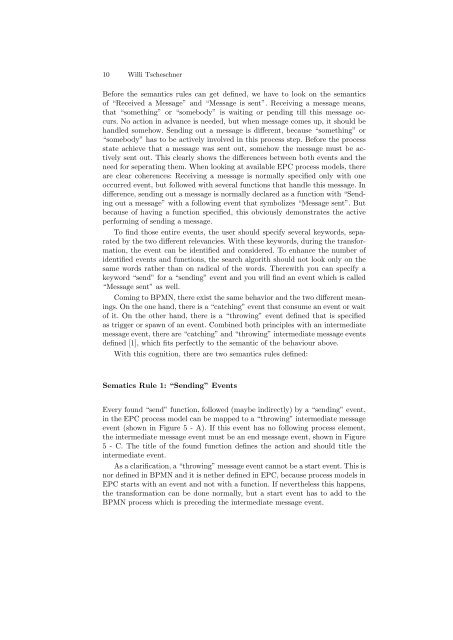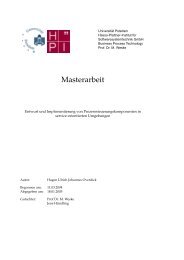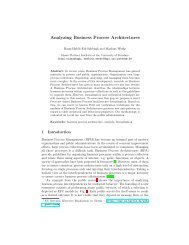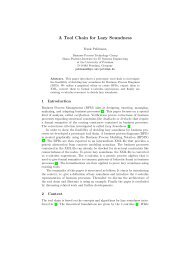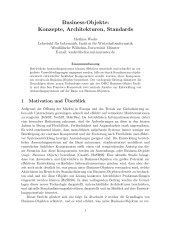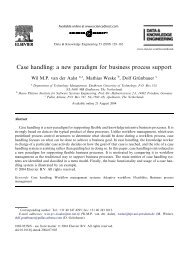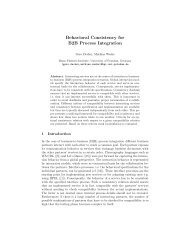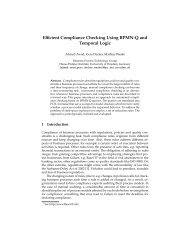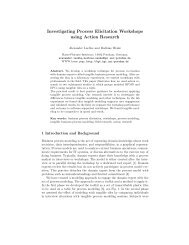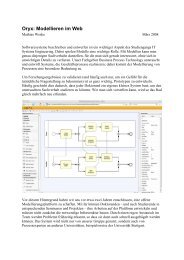Transformation from EPC to BPMN - Business Process Technology ...
Transformation from EPC to BPMN - Business Process Technology ...
Transformation from EPC to BPMN - Business Process Technology ...
Create successful ePaper yourself
Turn your PDF publications into a flip-book with our unique Google optimized e-Paper software.
10 Willi Tscheschner<br />
Before the semantics rules can get defined, we have <strong>to</strong> look on the semantics<br />
of “Received a Message” and “Message is sent”. Receiving a message means,<br />
that “something” or “somebody” is waiting or pending till this message occurs.<br />
No action in advance is needed, but when message comes up, it should be<br />
handled somehow. Sending out a message is different, because “something” or<br />
“somebody” has <strong>to</strong> be actively involved in this process step. Before the process<br />
state achieve that a message was sent out, somehow the message must be actively<br />
sent out. This clearly shows the differences between both events and the<br />
need for seperating them. When looking at available <strong>EPC</strong> process models, there<br />
are clear coherences: Receiving a message is normally specified only with one<br />
occurred event, but followed with several functions that handle this message. In<br />
difference, sending out a message is normally declared as a function with “Sending<br />
out a message” with a following event that symbolizes “Message sent”. But<br />
because of having a function specified, this obviously demonstrates the active<br />
performing of sending a message.<br />
To find those entire events, the user should specify several keywords, separated<br />
by the two different relevancies. With these keywords, during the transformation,<br />
the event can be identified and considered. To enhance the number of<br />
identified events and functions, the search algorith should not look only on the<br />
same words rather than on radical of the words. Therewith you can specify a<br />
keyword “send” for a “sending” event and you will find an event which is called<br />
“Message sent” as well.<br />
Coming <strong>to</strong> <strong>BPMN</strong>, there exist the same behavior and the two different meanings.<br />
On the one hand, there is a “catching” event that consume an event or wait<br />
of it. On the other hand, there is a “throwing” event defined that is specified<br />
as trigger or spawn of an event. Combined both principles with an intermediate<br />
message event, there are “catching” and “throwing” intermediate message events<br />
defined [1], which fits perfectly <strong>to</strong> the semantic of the behaviour above.<br />
With this cognition, there are two semantics rules defined:<br />
Sematics Rule 1: “Sending” Events<br />
Every found “send” function, followed (maybe indirectly) by a “sending” event,<br />
in the <strong>EPC</strong> process model can be mapped <strong>to</strong> a “throwing” intermediate message<br />
event (shown in Figure 5 - A). If this event has no following process element,<br />
the intermediate message event must be an end message event, shown in Figure<br />
5 - C. The title of the found function defines the action and should title the<br />
intermediate event.<br />
As a clarification, a “throwing” message event cannot be a start event. This is<br />
nor defined in <strong>BPMN</strong> and it is nether defined in <strong>EPC</strong>, because process models in<br />
<strong>EPC</strong> starts with an event and not with a function. If nevertheless this happens,<br />
the transformation can be done normally, but a start event has <strong>to</strong> add <strong>to</strong> the<br />
<strong>BPMN</strong> process which is preceding the intermediate message event.


